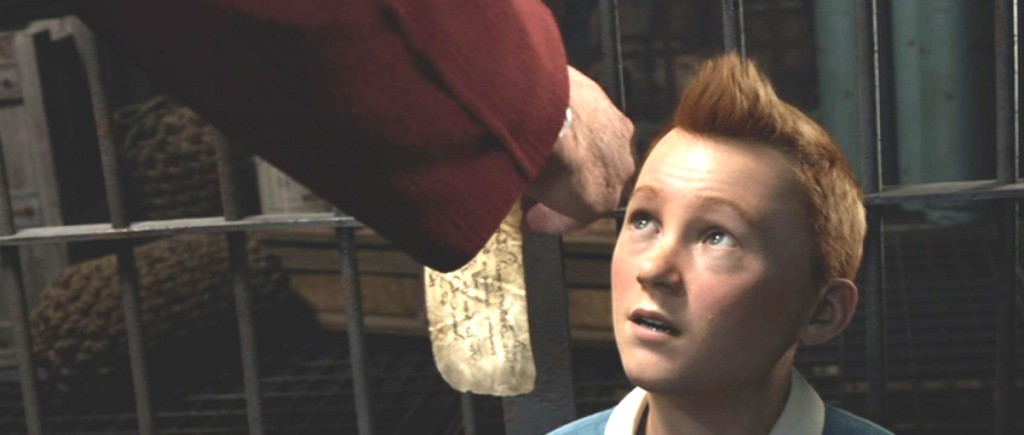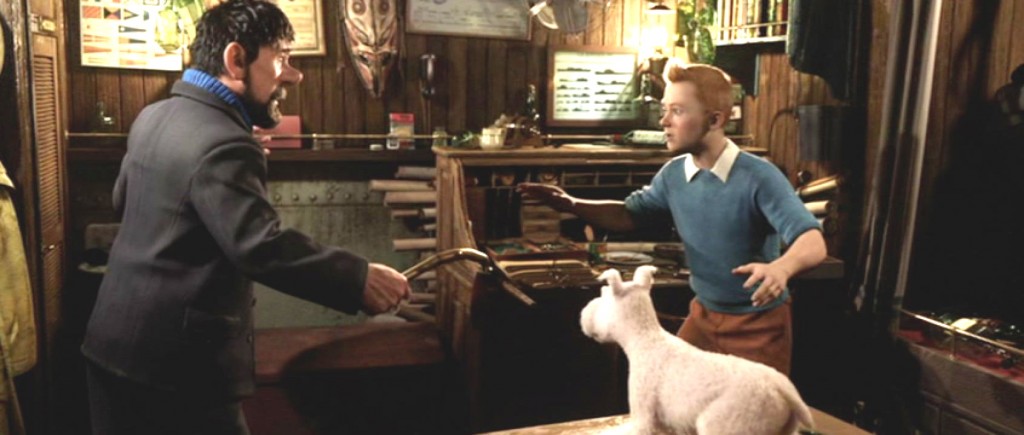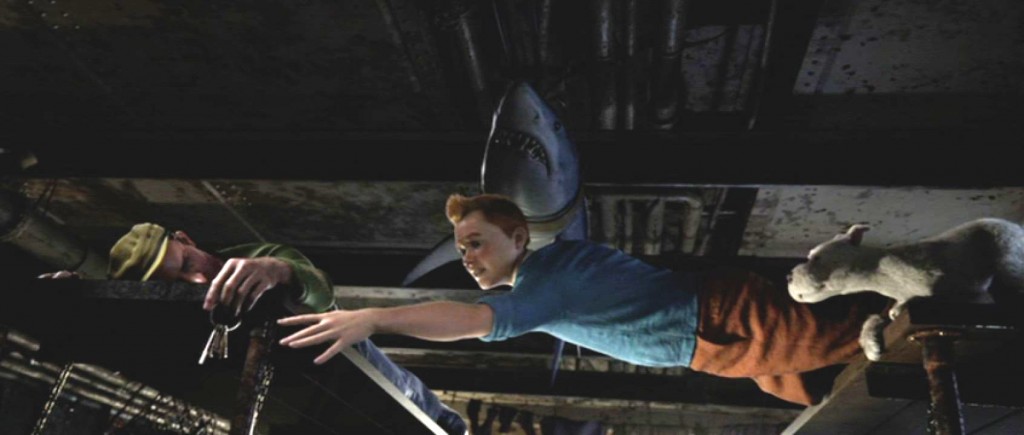Spielberg: The Adventures of Tintin part 4
Tintin is captured by some roughnecks and brought to, not the Unicorn but another ship, a modern ship, the Karaboudjan. I was kind of hoping that “Karaboudjan” was an Armenian word for “unicorn” or some other mythological creature, but alas no, it is merely a darkly romantic nonsense word meant to evoke Mideastern intrigue. Since our protagonist has been shoved into a crate for his journey to the Karaboudjan, Spielberg temporarily shifts the narrative’s focus to Tintin’s avatar Snowy, who, in another physical-comedy-laden chase scene, follows the crate to the docks and thence on board the ship.
Tintin is placed in a cage in the ship’s hold and interrogated by Sakharine, who apparently has hired this vessel. Again, Sakharine and Tintin almost see eye to eye, the boy adventurer and the grown-up obsessive. Sakharine has one scroll (from his own Unicorn model), Tintin has lost his (to the pickpocket), Sakharine now needs Tintin (his younger self) to find a third scroll.
Sakharine is Hook to Tintin’s Peter, two sides to the same coin, or the same person on different sides of the hill. The boy who seeks adventure will eventually become a desperate, grasping pirate — unless he never grows up, which is, of course, the secret to Tintin’s enduring popularity: Tintin doesn’t age, doesn’t develop, doesn’t seek out romantic love or family or property. He is always a boy, without responsibility, not even to his dog. He’s without parents, without a childhood even, he seems to have simply emerged into his world as a fully-formed prepubescent asexual teenager, old enough to drive or pilot a plane or shoot a gun, but not old enough to yearn toward permanence. No wonder Spielberg was drawn to him, at his heart Spielberg has always been most comfortable in the role of the 15-year-old boy. He moved past his boyish obsessions and went on to create fully mature works like Schindler’s List and Munich, but you can sense his glee in being able to retreat back into the wholly imaginary world of Tintin: he’s Peter Pan without the tragedy.
Tintin escapes from his cage with some help from Snowy and meets the captain of the Karaboudjan, Haddock, of the aforementioned cursed Haddocks. Haddock has had his ship hijacked by Sakharine, he is the only holdout of the crew, the others have gladly gone to Sakharine’s side, modern-day pirates on a whole new Unicorn. Haddock has his own issues with maturity and responsibility: he’s a drunk, his cabin is strewn with empty bottles. He is, in his own way, another dark side of Tintin. If Sakharine is Tintin grown up, Haddock is Tintin grown up without ambition. Haddock went to sea, and to seed, no doubt looking for adventure, and no doubt looking to escape adulthood. Alcoholism as a disease has no place in the Tintin universe, it is a definite choice, the choice of a man abjuring responsibility even for his own ship. Sakharine refers to the Karaboudjan‘s first mate as “treacherous,” but who would choose to remain loyal to a captain with no goal further than his next bottle of whiskey? A captain must steer the ship, not founder his sensibilities.
Haddock, we learn, knows the secret of the Unicorn, or did, once, before he drank his memory away. Haddock has something Tintin does not: a heritage, and his alcoholism has betrayed it. I don’t think The Adventures of Tintin is supposed to be a serious examination of the effects of alcohol (although Haddock would make a good comparative to Denzel Washington’s drunk pilot in Flight), but it seems pointed that the first cast member of Tintin with a family has destroyed it with the bottle. The destruction of the family is, of course, Spielberg’s career-long central theme, his Rosebud as it were, so it’s not surprising that, as Act II of Tintin begins, the movie becomes Haddock’s. Spielberg may wish to retreat into the nostalgia Tintin evokes, but it’s Haddock that he gets to sink his narrative teeth into. We know that Tintin‘s narrative will not rest until Haddock has reinstated his heritage, reintegrated his family.
Tintin’s first adventure with Haddock is an enjoyable bit of hugger-mugger where Haddock must get a key from a sleeping sailor. He sends Tintin into a cabin filled with unsavory salts — a gambler who lost his eyelids in a poker game, a razor-wielding thug and a man openly described as a sheep-molestor. It’s understandable that Haddock doesn’t want to face these men himself, but his description of the men, in any kind of realistic sense, is horrifying, and the last place one would want to send a 15-year-old boy. Of course, the world of Tintin is essentially harmless, and the all-important keys turn out to open only the liquor cabinet. The beat cements Haddock’s relationship to both Tintin and to alcohol: he is a coward who would put a boy in the hands of murderers to satisfy his craving for escape.
While Haddock prepares to escape by lifeboat, Tintin goes to the ship’s radio room and does some detective work. He learns that the ship is headed to Morocco, where there is a sultan with the third model of the Unicorn. To entertain the viewer during Tintin’s recitation of exposition, Spielberg lets Snowy tussle with a rat over a sandwich.
Tintin, of course, doesn’t need to find the third model of the Unicorn, if his only goal were self-preservation he’d just go home (wherever “home” is). Tintin’s goal isn’t even to help Haddock save his heritage or to foil Sakharine in his quest for whatever-he’s-questing-for, his only goal is to get the story. The crew finds him, leading to a ship’s-deck fight that allows Tintin to fight, leap, shoot and scramble to safety. He reveals himself to be a hugely competent fighter, especially when contrasted with Haddock, a sea captain who’s incapable of even lowering a lifeboat. Tintin and Haddock are now thrown together at sea, two pieces of Sakharine’s puzzle, on their way to the next story point.



without responsibility, not even to his dog
Maybe it’s a Belge cultural issue, but the lack of collar/tag on Snowy gets to me now that I’ve got a dog. Snowy, like Tintin, can’t be tied down. Or fed regular meals, apparently. (No wonder he’s always fighting with other animals, he’s starving.)
his cabin is strewn with empty bottles
What kind of a captain is Haddock to have all those empty bottles and no tiny (model) ships inside them? Tintin has the model boat (briefly) while Haddock has the empty bottles (or empty memory). If only they could join up…
After the father/mother issues in X-Men First Class, it’s interesting how little family plays a role here and how many relationships are mirroring rather than familial. (Doh, Tintin first sees the ship at the market in the mirrors.) Like Tintin-Sakharine, Tintin-Haddock, Tintin-Snowy–they’re all forms of the boy adventurer with no pretense of interest in each other beyond their need (Tintin-story, Sakharine-story’s treasure, Haddock-obliteration of story through drink).
(As for those who don’t fit the boy adventurer form, I’m sure there’s other mirroring going on; Thompson and Thomson are merely mirrors of each other.)
And not just mirrors but lenses. Tintin and the viewer keep seeing things through glass. The model ships, Haddock’s face, Tintin’s typewriters, Tintin’s headlines. There’s a lot of framing and reflecting and disorting going on.